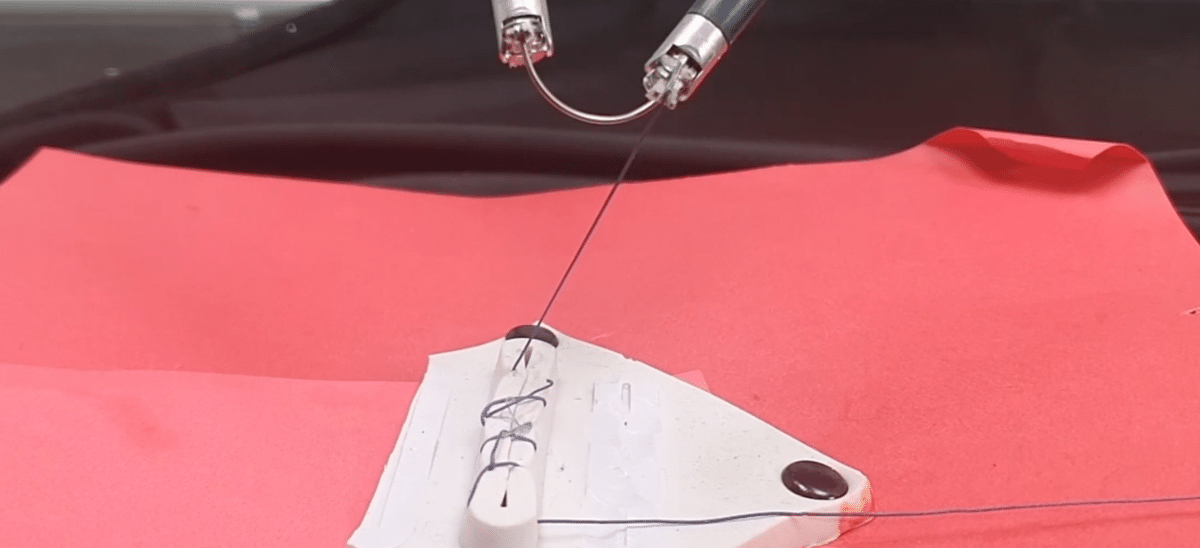Automation: This robot sews up a wound with six stitches all by itself
A small pang for a robot, a big step for robotics: This is how one could paraphrase the advance that researchers from the University of California, Berkeley have now presented. A video shows how a two-armed robot independently sutures a wound in imitation skin with six stitches. He passes the needle through the soft, yielding tissue from one robot arm to the other while keeping the thread taut.
Advertisement
Although robots are now involved in many procedures such as inguinal hernias and coronary bypasses, they only support surgeons – not replace them. This new research shows the way to robots that can work more autonomously in the operating room for very complicated tasks such as sewing and relieve the burden on the medical team. But the sewing robot could also be useful in other areas of robotics beyond the operating room.
“From a robotics perspective, this is a really challenging manipulation task,” says Ken Goldberg, a researcher at UC Berkeley and head of the lab that worked on the robot.
Challenge for sewing robots
The robot has to overcome important hurdles for its use in the operating room: What is difficult, for example, is that shiny or reflective objects such as needles can disrupt a robot’s image sensors. In addition, computers have difficulty modeling how “deformable” objects such as skin and thread react when they are pierced and punctured. Unlike passing the needle back and forth from one human hand to another, moving a needle between robotic arms is an immense dexterity challenge.
To meet the challenges, the robot uses two cameras to capture the environment. The researchers trained it with a neural network so that it was able to recognize where the needle was and, using motion control, could plan all six movements required for a stitch.
The fact that such robots can independently suture wounds and organs in operating rooms is still a thing of the future. But automating part of the sewing process offers serious medical potential, says Danyal Fer, a doctor and researcher on the project.
Sewing process as a good candidate for automation
“There’s a lot to do during an operation,” says Fer, “and stitching is often the last task you have to do. The doctors can get tired while stitching. If they don’t close the wound properly, this can happen “Longer healing times and a number of other complications.” Since suturing is also a fairly repetitive task, Goldberg and Fer thought it was a good candidate for automation.
Whether the use of robots also achieves better results for patients or whether sutures heal faster and leave fewer scars: These questions are still open. Because the robot’s success should be viewed with caution: the number of six stitches was the maximum that the robot arms could manage before a human had to intervene. On average, the robot only managed around three stitches in the experiments. The test wound was limited to two dimensions, as opposed to a wound on a rounded body part such as the elbow or ankle. Additionally, the robot was only tested on “phantoms,” a type of fake skin used in medical training — not organ tissue or animal skin.
Axel Krieger from Johns Hopkins University, who was not involved in the study, said the robot has made impressive progress – especially in its ability to find the needle, grasp it and transfer it between its arms.
“It’s like looking for a needle in a haystack,” says Krieger. “It’s really difficult. I’m very impressed with how far they’ve come.”
Krieger’s laboratory is at the forefront of robotic sewing. But the team is taking a different approach. While the Berkeley researchers worked with the da Vinci Research Kit, a shared robotic system used in many operating rooms for laparoscopic surgery, Krieger’s lab built its own system, the Smart Tissue Autonomous Robot (STAR).
Distinguish between tissue and blood
A 2022 publication showed that the STAR could successfully place sutures in pig intestines. This was notable because robots typically have difficulty distinguishing colors in a sample of animal tissue and blood. The STAR system, for example, benefited from infrared sensors in the tissue that told the robot where to go and a specially designed sewing mechanism to place the stitches. The Berkeley robot was instead designed for hand sewing using the less specialized da Vinci system.
The list of challenges is therefore still long for both research approaches if robotic surgeons want to get off the ground. Krieger wants to make the robot easier for surgeons to use (its functions are currently hidden behind a wall of code) and train it to handle much smaller sutures.
Goldberg wants his lab’s robot to suture more complicated wound shapes and complete suturing tasks more quickly and accurately. The lab will soon switch from testing on imitation skin to animal skin. Chicken skin is preferred. “The nice thing about it is that you can just buy a chicken from the supermarket,” he says. “You don’t need a permit.”
(jl)
To home page
